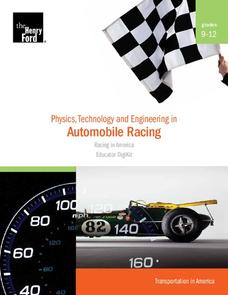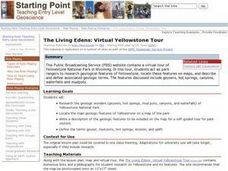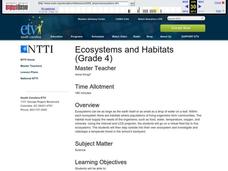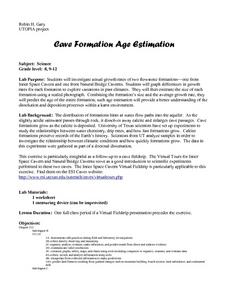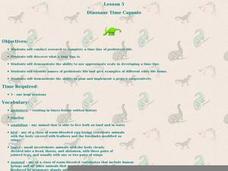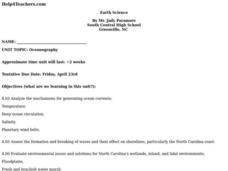Alabama Learning Exchange
Is it a Moth or a Butterfly?
Second graders examine the similarities and differences between moths and butterflies. They participate in a virtual field trip using a designated web site. They design a computer based slideshow using the information they find on the...
Henry Ford Museum
Physics, Technology and Engineering in Automobile Racing
Start your engines! This five-lesson unit introduces physics and Newton's laws through automobile racing. Each lesson includes background information, a student worksheet, and an answer key. There are also culminating...
Curated OER
Lunar Field Trip
Students take a virtual tour on Google Moon of what human life would be like on the moon. In this moon lesson plan, students also compose web diagrams, make charts, make a time line, investigate problems, and more.
Curated OER
The Living Edens: Virtual Yellowstone Tour
Students take an online virtual tour of Yellowstone National Park. They act as park rangers to research geological features of Yellowstone, locate these features on maps, and describe and define associated geologic terms.
Scholastic
Hillary Conquers Everest
If a field trip to the summit of Mount Everest isn't in your school budget, make the trek virtually! An interactive lesson allows class members to follow Sir Edmund Hillary and Tenzing Norgay's trail up the mountain, and provides...
Curated OER
Chucky Chickadee
Students create an original project dealing with birds. In this bird lesson, students take a virtual field trip to bird feeders around the nation. Students replicate the coloring of winter birds.
Curated OER
Ecosystems and Habitats
Fourth graders go on a virtual field trip to five ecosystems. They investigate and videotape a temperate forest in the school's backyard.
Curated OER
Classifying Seashells
Third graders practice classifying seashells. In this seashell classification instructional activity, 3rd graders listen to a guest speaker talk about collecting seashells. They participate in a discussion on the characteristics by which...
American Farm Bureau Foundation for Agriculture
Welcome to My American Farm!
Take a step into the virtual farm world and explore the impact farming has on our everyday eating habits. Future farmers discover the meaning of agriculture and the hard work that goes into providing food for us to enjoy. A computer...
Curated OER
Cave Formation Age Estimation
Students investigate growth rates of flowstone formations. They view a virtual field trip and discuss how flowstones form. They observe the cave fieldtrip and predict the growth rate for a cave formation. They graph growth rates and...
Curated OER
Dinosaur Time Capsule
Third graders research prehistoric life using educational software. They design a prehistoric life while showing the use of appropriate scale and names for the prehistoric life. They follow an internet link to participate in a virtual...
Curated OER
Earth Science
Students analyze the mechanisms for generating ocean currents, temperature, and deep ocean circulation. They are able to assess the formation and breaking of waves and their effect on shorelines, particularly the North Carolina coast. ...
Alabama Learning Exchange
Going Batty
Second graders participate in a research project involving bats. They collect information for their project on the Internet and other educational sites. They participate in a field trip to discover more about bats at the zoo.
Alabama Learning Exchange
Animal, Insect, and Bird Classification
After completing a unit on animal classification and attending a field trip students e-mail a trusted adult with some information about animal classification. They detail what they have learned about classifications of animals, insects...
Curated OER
ABC's of Dinosaurs
Students develop an ABC Book using KidPix Productivity software to create a multimedia slide show applying all they have learned about dinosaurs. They participate in a virtual field trip to find information.
Curated OER
Bell Live! The Great Lakes: A Superior Adventure
Students participate in a virtual field trip to Lake Superior. In groups, they perform experiments in which test the level of toxins and bacteria in the water. They also watch video segments life in the lake and discuss their observations.
Curated OER
Environment: Arctic Climate and Geoscience
Students conduct a thorough investigation of the Arctic and how climate change affects it. After listing a KWL chart, they record their findings on a bulletin board. Finally, in an Arctic Alive! interactive lesson, students take a...
Curated OER
Animal Hide and Seek
Students examine how animals use their colors to their advantage. They read the book, "Brown Bear, Brown Bear, What Do You See?," participate in a toothpick camouflaging demonstration, explore the Camouflage Field Book website,...
Kenan Fellows
Designing a Water Treatment Plant
How does dirty water get clean enough to drink? After viewing a PowerPoint that outlines the process water goes through at a water treatment plant, groups work together to design a chlorination chamber for a treatment plant.
Curated OER
The Science Behind Dolphins
Students discover facts about marine mammals, specifically dolphins. In this K-2 lesson plan, students identify the different species of Cetaceans, focusing on dolphins. Students answer true/false questions regarding cetaceans and...
Curated OER
Sea Horse Habitats
Students research sea horses around the world. In this sea horse habitats lesson, students use the Internet to take a virtual tour of a sea horse in its natural habitat. Students work in groups to study a geographical region...
Curated OER
Chesapeake Bay Population Studies
Young scholars determine how to use a quarter meter quadrant to find population density, relative density, frequency and how to calculate a diversity index while participating in a virtual field trip. They study how to establish a...
Curated OER
Use Google Maps to Teach Math
Capture the engagement of young mathematicians with this upper-elementary math lesson on measuring time and distance. Using Google Maps, students first measure and compare the distance and time it takes to travel between different...
Florida International University
The Good, the Bad and the Nasty Tasting
Examine the benefits of chemical defense mechanisms. Organisms in oceans use chemicals to ward off predators. Duplicate this adaptation using a hands-on experiment in which you ward off your predators (your pupils) with some...



